
In the ancient Dacian metropolis, the Temple of Jupiter has been discovered
 |
According to the head of the excavation, Ioan Pisa, researchers found the structure over a quarter of a century ago, but only now have they managed to prove that the most important temple of this Roman province indeed stood in the ancient metropolis of Dacian rulers and later the administrative center of the Roman province of Dacia Sarmizegetusa.
The discovery demonstrates that in the year 150, during the reign of Emperor Antoninus Pius, the cult of Jupiter and the Capitoline Triad, consisting of Jupiter, Juno, and Minerva, was officially established in Dacia.
According to Roman models, a Capitol was built in every capital of conquered territories, however, this temple had never been found in the territory of ancient Dacia (present-day Romania) until now.
The temple covers several hundred square meters and its walls are two meters thick. The building's foundations are made of massive stone blocks. "The statue of Jupiter must have been placed very high, so that he could oversee the walls of the city under his protection from his throne," reminded Piso.
Sarmizegetusa was the capital of the Dacian king Decebalus. However, after losing a battle, he became a Roman vassal, and his land became a province of the Roman Empire from the years 106 to 256.
The ancient Dacian tribe was monotheistic: their sole god of the heavens was Zalmoxis. They later converted to Christianity, aided by the apostle Andrew.
The English translation is powered by AI tool. Switch to Czech to view the original text source.
0 comments
add comment












